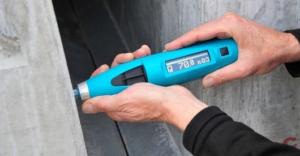Rebound Hammer Test its Objective & Principles
Rebound Hammer Test
Rebound Hammer test, which is also called as the Schmidt hammer test. It is a non-destructive test. We perform this test only on hardened concrete to determine the hardness of the surface and its strength. We can control the hardness of the surface to some extent with the concrete strength.
This test provides a convenient and rapid indication of the compressive strength of hardened concrete.
Its apparatus consists of a spring controlled mass that slides on a plunger within a tubular housing. If a rebound hammer plunger is pressed against the surface of hardened concrete, a spring controlled mass having constant energy is made to hit the concrete hard surface to rebound back.
The rebound hammer measures a surface hardness and is measurement shown on a graduate scale.

Objectives of the rebound hammer test:
Rebound hammer test calculates the compressive strength of hardened concrete by relating the compressive strength and the rebound index.
- This test accesses the uniformity of concrete very easily.
- This test also accesses the quality of hardened concrete as per IS standard specification.
- Rebound hammer test relates one concrete element with other concrete elements in terms of quality.
We use this test to differentiate the questionable and acceptable parts of the structure or base on its strength comparison between two different structures.
Procedure and Principal
We use the rebound hammer to get an indication of the concrete strength. The device of the rebound hammer test is about 1 foot long and encloses a mass and a spring. The spring-loaded mass is released to hit on the surface of the hardened concrete.
The mass rebounds and the amounts of a rebound are read on a scale. The larger the rebound, the harder is the concrete and hard surface and the greater will be the strength.
The Rebound hammer test device usually comes with graphs prepared by the manufacturer to relate rebound to the strength of concrete. We also use the Rebound hammer test to check out the uniformity and quality of the concrete surface.
This test is very simple and easy to run and is specified by ASTM C805. To perform the rebound hammer test, the hammer must be perpendicular to a smooth and clean concrete surface. In some cases, it would be hard to satisfy this condition. The correlations should be provided by the manufacturer, can be used to relate the strength to the amount of rebound at different angels.
Factors Affecting this Test
The tests result of the rebound hammer test is affected by several other factors.
- Local vibration
- Coarse aggregate particles on the surface
- Existence of voids near the surface
- Concrete age
- Moisture on surface
- Cement type
- Carbonation
- smoothness and cleanness of the surface
- the rigidity of test area
- reinforcement located in concrete.
To reduce the effect of these factors it is desirable to average 10 to 12 reading from different points in the concrete test surface area.
Advantages:
- It is very simple to use in building constructions.
- No special equipment and experience are required to conduct the test.
- For the rehabilitation of the old monument.
- The device of this test is inexpensive and is easily available in the market.
- This test is available with an operational range of M10 to M 70 concrete mix.
Read Also:
